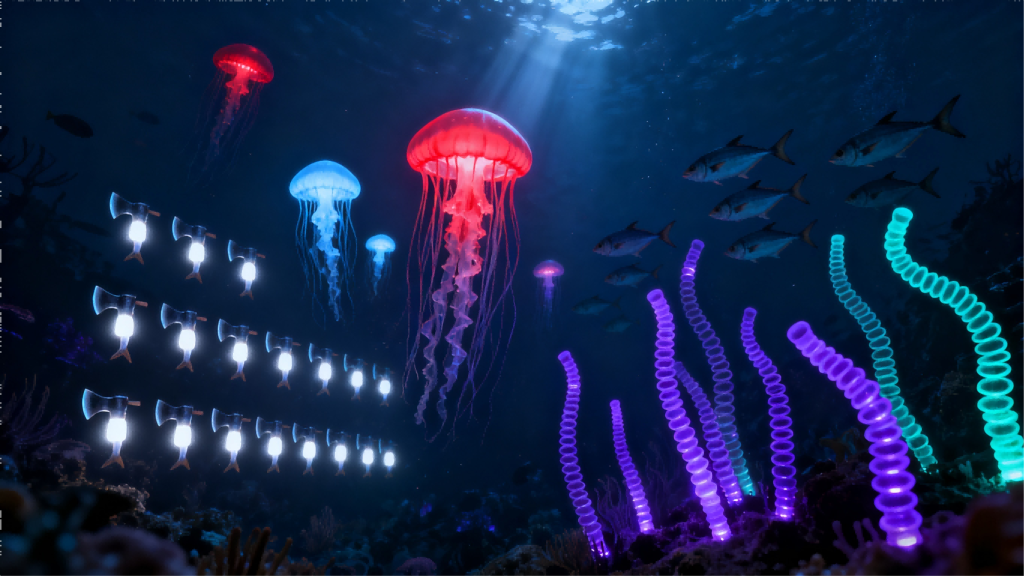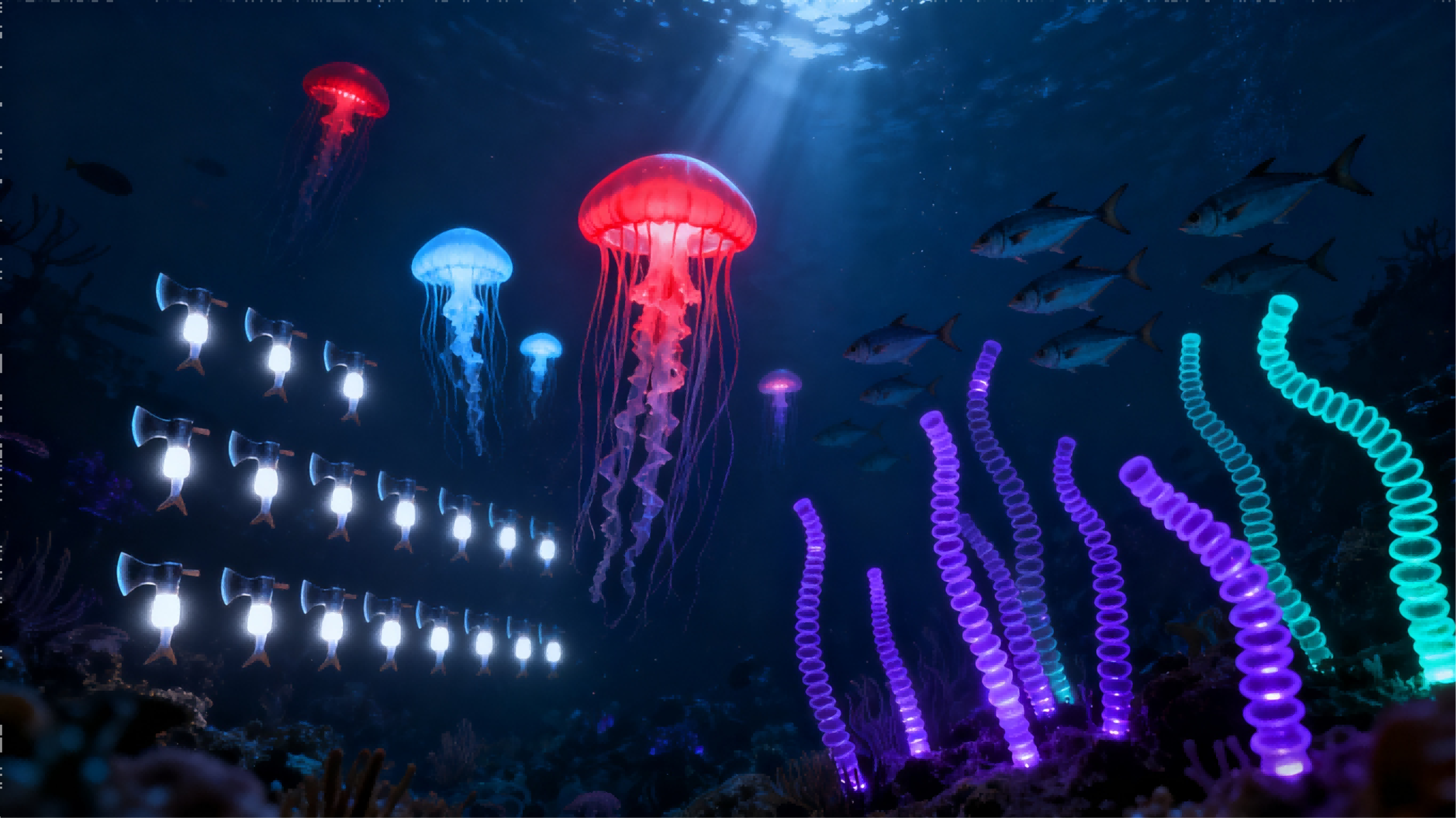
The ocean’s depths, a realm of perpetual darkness and immense pressure, are home to some of the most extraordinary and alien-like creatures on our planet. Far from the sunlit surface, these organisms have evolved in astonishing ways, adapting to an environment that would be instantly fatal to most life forms. Their bizarre shapes, glowing bodies, and unique survival strategies make them subjects of endless fascination for marine biologists and oceanographers. From the abyssal plains to the hydrothermal vents, the deep sea is a frontier of discovery, a place where every expedition brings to light new wonders and unravels the mysteries of evolution in its most extreme form.
One of the most iconic residents of the deep sea is the anglerfish. With its gaping mouth full of razor-sharp teeth, the anglerfish is a truly terrifying predator. However, what makes it truly unique is its method of hunting. A bioluminescent lure, a fleshy appendage that dangles from its head, glows in the dark, attracting unsuspecting prey. This lure is not just a simple light source; it’s a complex organ called the esca, which can be wiggled and flashed to mimic the movements of small organisms. When a curious fish or shrimp approaches the light, it’s instantly swallowed by the anglerfish’s massive jaws. This predatory strategy is a perfect example of adaptation, allowing the anglerfish to thrive in an environment where food is scarce and every opportunity must be seized. The female anglerfish is significantly larger than the male, and in a truly bizarre twist of nature, the tiny male will often fuse with the female, becoming a permanent part of her body and providing a constant supply of sperm for reproduction.
Another marvel of deep-sea life is the vampire squid. Despite its menacing name, this creature is not a squid and is relatively harmless. It gets its name from its webbed arms, which it can invert over its body to form a cloak-like structure, and its deep red color. The vampire squid is a living fossil, an ancient lineage that has survived for millions of years. It doesn’t hunt like other squids; instead, it’s a detritivore, feeding on “marine snow”—a constant shower of dead organic matter that drifts down from the upper layers of the ocean. To avoid predators, the vampire squid has a unique defense mechanism. When threatened, it can eject a cloud of glowing, sticky mucus that can disorient and distract its attacker, allowing the vampire squid to make a quick escape. This is a far cry from the ink clouds used by other cephalopods and highlights the unique evolutionary path this creature has taken.
Then there’s the goblin shark, a truly prehistoric-looking fish with a long, flattened snout that resembles a blade. Its most striking feature, however, is its protrusible jaws, which it can thrust forward to snatch prey. This grotesque appearance has earned it the nickname “living fossil,” as it’s the only surviving member of a family of sharks that dates back 125 million years. The goblin shark is a deep-sea ambush predator, using its highly sensitive snout to detect the weak electrical fields of its prey. When it gets close enough, it snaps its jaws forward with incredible speed, a mechanism that scientists are still trying to fully understand. Unlike the streamlined predators of the surface, the goblin shark is a slow and sluggish fish, perfectly adapted to a life of lurking and ambushing in the dark. Its discovery and ongoing study are a testament to the fact that there are still so many ancient creatures waiting to be found in the ocean’s twilight zone.
The deep sea is also home to creatures that thrive in the most extreme conditions imaginable, such as the hydrothermal vents. These volcanic openings on the seafloor spew out superheated, mineral-rich water, creating a unique ecosystem where life thrives without sunlight. The tube worms that live here are a prime example. These worms, which can grow to several feet in length, have no mouth, no stomach, and no anus. They survive through a symbiotic relationship with bacteria that live inside their bodies. The bacteria convert the chemicals from the vents into energy, and the worms, in turn, provide the bacteria with a home. This incredible form of life, based on chemosynthesis rather than photosynthesis, completely redefines our understanding of where and how life can exist.
The Dumbo octopus, named for the large, ear-like fins on its head that resemble the famous cartoon elephant, is another enchanting deep-sea resident. Unlike other octopuses, the Dumbo octopus doesn’t use jet propulsion to move. Instead, it “flies” through the water by flapping its fins, a graceful and elegant movement that stands in stark contrast to the often-jerky motions of other cephalopods. The Dumbo octopus is a bottom-dweller, feeding on worms, crustaceans, and other small organisms it finds on the seafloor. Its charming appearance and unique mode of locomotion make it one of the most beloved creatures of the deep, and a reminder that even in the darkest corners of the world, there is still beauty to be found.
As technology advances, we are able to explore the deep sea in more detail than ever before, revealing a world that is more diverse and complex than we could have ever imagined. Each new discovery challenges our preconceptions about life, evolution, and the limits of biology. The deep sea is not just a void of emptiness; it is a vibrant, thriving, and deeply mysterious realm that continues to captivate our imagination and beckon us to explore its uncharted territories. The creatures that live there are not just curiosities; they are a testament to the incredible resilience and adaptability of life itself. The more we learn about them, the more we understand our own place in the grand tapestry of life on Earth.
